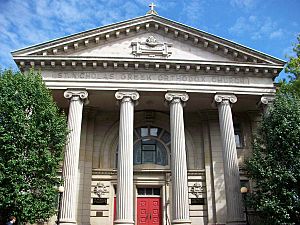Saint Nicholas Greek Orthodox Cathedral (Pittsburgh) facts for kids
Quick facts for kids Saint Nicholas Greek Orthodox Cathedral |
|
|---|---|
 |
|
| 40°26′40.08″N 79°56′59.91″W / 40.4444667°N 79.9499750°W | |
| Location | 419 South Dithridge Street (Oakland), Pittsburgh, Pennsylvania |
| Country | United States |
| Denomination | Greek Orthodox Church |
| Website | https://www.stnickspgh.org/ |
| Architecture | |
| Architect(s) | Thomas Hannah |
| Administration | |
| Archdiocese | Archdiocese of America |
| Metropolis | Metropolis of Pittsburgh |
The Saint Nicholas Greek Orthodox Cathedral is a beautiful church located in the Oakland neighborhood of Pittsburgh, Pennsylvania. It was designed by an architect named Thomas Hannah and finished in 1904.
This building was first used by the First Congregational Church until 1921. Since 1923, it has been a Greek Orthodox Church. Today, it is an important part of the Greek Orthodox Archdiocese of America. It is also the main church for the Greek Orthodox Metropolis of Pittsburgh. This church building has a special style called Classical Revival. It was recognized as a historic landmark in 1982.
Contents
What is the Saint Nicholas Cathedral?
The Saint Nicholas Greek Orthodox Cathedral is a place of worship. It serves the Greek Orthodox community in Pittsburgh. The church has a long history in the city. It stands as a landmark due to its unique design.
A Look at the Building's Design
The cathedral has a grand entrance called a portico. This portico is made of sandstone. It features tall columns in the Ionic style, which comes from ancient Greece. This design makes the church look very impressive.
The outside of the church has large, round-arched windows. These windows let in a lot of light. The building's design is strong and eye-catching. It uses yellow industrial brick.
Inside the Cathedral: Art and Beauty
The inside of the cathedral is filled with amazing art. You can see many paintings and mosaics. One special painting is in the dome. It shows Christ the Pantocrator, which means "Ruler of All." This painting has a background made of gold leaf.
Another important feature is the iconostasis. This is a screen covered with icons. It separates the altar from the main part of the church. The iconostasis here is made of metal and mosaic. It has beautiful peacocks shown on the Royal Doors. Inside the sanctuary, there are more artworks. These include a painting of the Mother and Child. There is also a fresco of the Last Supper.
More to Explore
Related Places
- List of cathedrals in the United States
- List of Pittsburgh History and Landmarks Foundation Historic Landmarks
Find Out More Online
- St. Nicholas Greek Orthodox Cathedral Official website

